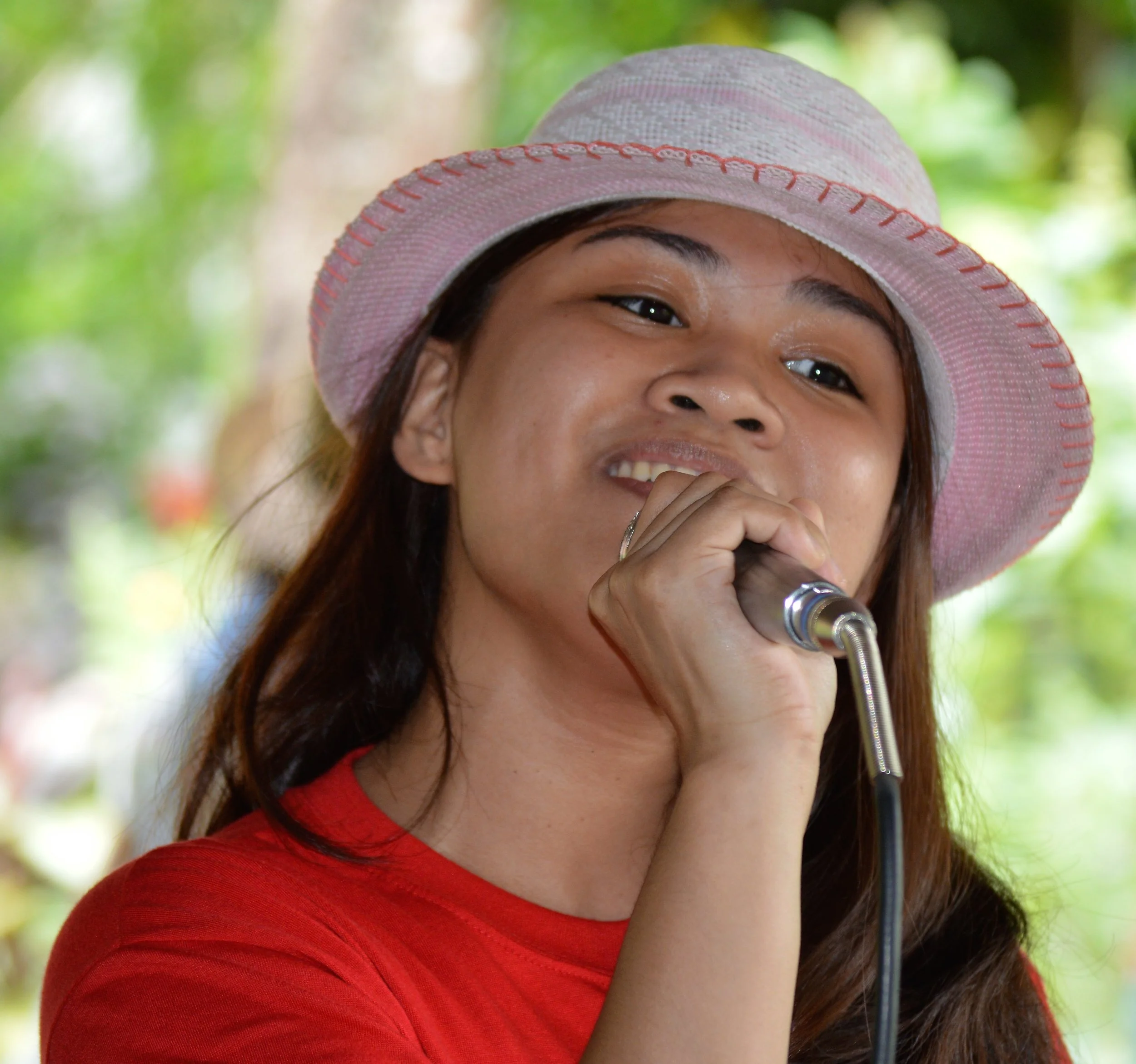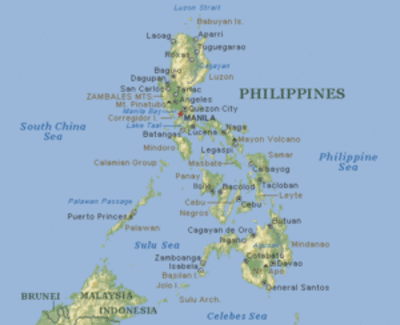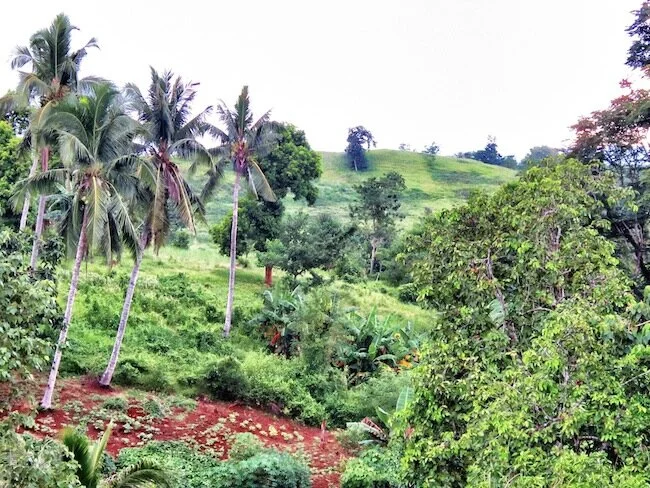B.J. Stolbov reflects on how three simple phrases—"Not my problem," "I don’t know," and "I have no opinion"—help him cut through the noise of daily life. With warmth and honesty, he shares how these words keep him grounded, free from unnecessary stress, and focused on what really matters. His personal story might just inspire you to embrace a simpler, more peaceful approach to life in 2025.
All tagged Philippines
Infrastructure Less Taken
A road trip across the Philippines via winding mountain roads and ferry crossings en route to a family reunion gets expat B.J. Stolbov thinking about President Rodrigo Duterte’s ‘Build, Build, Build’ infrastructure projects designed to promote the flow of goods, investment, and people. And inspires the question: Who will benefit?
Honesty Island
Philippines-based American expat B.J. Stolbov heads off to Batanes, a remote cluster of islands, located almost 200 miles off the northernmost tip of Luzon, to discover if the islands are as crime-free as their reputation.
Singing in The Philippines
If you travel to the Philippines, where singing is a national pastime, American expat B.J. Stolbov advises you to let go of inhibition and join the fun.
Searching for the Familiar
Many of us travel in search of the different, the unusual, the exotic. But, for B.J. Stolbov, wherever he travels, he often finds himself searching for the familiar. Not the things that remind him of “back home,” but, rather, the moments of connection—to others, to nature, to himself—that each journey inspires.
Hidden Philippines: Tropical Mountains Beyond and Above the Beach
There's more to the Philippines than white sandy beaches, clear blue ocean, soothing waves, and swaying palms trees. When American expat BJ Stolbov settled in the Philippines, he traveled beyond and above the tourist-laden beaches to a world of lush tropical mountains and indigenous tribal culture and people. Discover his insider tips for exploring the mountains of northern Luzon.
Fishing for a Future
by B.J. Stolbov
When I was young, my father took me on a father-son bonding/camping/fishing trip to some unpronounceable lake in upstate New York. I learned to squeamishly poke a hook through a wiggling worm. I learned to awkwardly cast a fishing line out into the lake. And when I did catch a fish, with the point of the hook sticking out through its eye, I immediately learned, while screaming and crying, that I was no fisherman. No fisherman either, my father and I gratefully agreed to bond by never going fishing again.
Stay and Away
Two young men, Juan and José sit, side-by-side, day after day, week after week, month after month, year after year, beside the road, watching the cars and the vans and the trucks and the buses going by.
Both are high school graduates, but no more than that; neither of their families could afford to send them to school anymore.
Juan lives on this side of the road. He helps around the house, helps to raise his younger brothers and sisters, and helps in his mother’s ukay-ukay (used clothing) store. Juan has not heard from his father for years.
Touring for Gold: Traveling in an Economy
by B.J. Stolbov
I’ve often wanted to see where the gold in my wedding ring came from, or the gold in a bracelet and necklace, or the gold in a camera, cell phone, and computer. (Yes, there’s gold in a computer!)
Didipio Gold Mine isn’t easy to get to. It’s in an isolated corner of Quirino Province in Northern Luzon in the Philippines. It’s more than an hour’s drive from the nearest town, Didipio. The narrow, gravelly road twists and turns, up and down, through hills and valleys, untouched and unspoiled, lush and green, with stands of coconuts and groves of bananas, lots of bananas. Only a few houses can be seen from the road. The mine is out-of-the-way in one of the least populated areas in one of the least populated provinces in the Philippines.
“It’s A Blessing!” A Filipino Wedding
On a sunny dry day, about an hour before the wedding, it begins to rain; the skies open up, dumping torrents of tropical rain, and I say to the family of the bride, “I’m sorry about the rain.”
“It’s a blessing!” they reply.
An hour later, it’s again sunny and dry, and outside the church on the island of Mindoro in the Philippines, the bride is waiting, dressed in her full wedding gown, inside an air-conditioned van.
“It’s a blessing!”
The groom is waiting outside the church, in the increasing heat; he is spotlessly clean and his hair neatly combed.
What is land? Land can have many different meanings. Land can mean wealth, profit, prosperity, privilege, prestige, power, control, status, accomplishment, satisfaction, success, fame, respect, honor, dignity, safety, security, stability, continuity, contentment, freedom, happiness, hope, joy, beauty, love...
Land, for most people of the world, means wealth. Wealth, like beauty and love, is in the eye of the beholder.
Deep in the barren Sonora Desert of Southwestern U.S, three days away from the last person I saw, I was hiking alone, in search of quiet. The desert has always been the one place that spiritual seekers, saints, and sinners have gone in search of quiet.
Sonoran Desert, Prima, Arizona. Photo by Ken Bosma via Flickr CCLExcept that, in reality, the desert was not quiet. Its incessant winds whistled by my ears and rumbled up through my feet. Dead and dying grasses tumbled and rolled by. Snakes slithered, lizards clicked, and hares scurried across the sand. The winds sang beneath the wings of hovering vultures and under the claws of lingering thoughts.
There, hiking alone through the desert, reveling in my own silence, late in the afternoon on a tranquil summer’s day, I suddenly came upon a rattlesnake, which startled me with its rattle, louder than any rock concert I had ever been to. I stopped, the snake did not strike, we stared at each other, and then we both quietly went our separate ways.
Sound and silence can come in unanticipated places and at unpredictable times.
When I was 11 years old, my father took my 15-year-old-sister and me on a cross-country car trip from Tamaqua, Pennsylvania to Seattle, Washington to San Diego, California, and back in 30 days. What I remember about the trip was my father saying, “Here we are at the Space Needle (or Disneyland or the Grand Canyon or wherever), you have 10 minutes, take some pictures, I’m going to the souvenir shop to buy some pennants.” (For some reason, we got into collecting pennants that ended up on the walls of our basement.) My father drove 10,000 miles in 30 days, and I got to see the U.S.A. at 60 miles per hour.
Floating on the Ocean
by B.J. Stolbov
Pagudpud is not a promising name for a beach town.
Boracay – now that’s a great name for a beach town. Boracay is an island between the Tablas Strait and the Sibuyan Sea in the Visayan Islands of central Philippines. This is the place where people, many foreigners, go when they want to go to a beach. Here are white sandy beaches and deep blue waters, planted coconut palms and scheduled ferries, harbors for sailboats and large yachts, expensive hotels and designer resorts, gourmet restaurants and fast-food joints, beautiful women in tiny bikinis and handsome shirtless men, hot sunny days and wild drunken nights, 24-hour bars and all-night discos, music, singing, laughing, fun, affairs, romance, sex, secrets, exciting evenings, and, maybe, a regret-filled morning. Boracay.
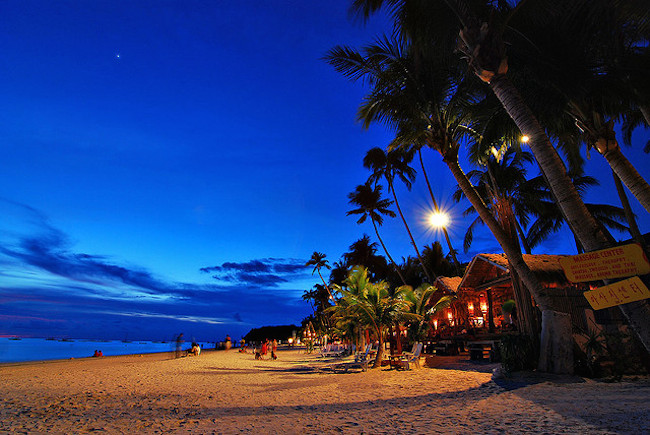 Boracay Beach at Dusk/ Flickr.com
Boracay Beach at Dusk/ Flickr.com
Pagudpud sounds like one of those small, lost towns in northern New Jersey. Pagudpud is a small, lost town in northern Ilocos Norte. It is the most northern town in the most northern province on the northern island of Luzon. From Manila, it’s a 10 to 12 hour bus trip. But when Filipinos want to get away, they go to Pagudpud.
Pagudpud is a tranquil, isolated town nestled between the South China Sea and the Cordillera Mountains. Protected by the mountains, few storms threaten up here. The weather is warm, but not hot. The ocean is clear, blue, and unpolluted. The fishermen, in their hand-built boats, are out early in the mornings, tending their nets. Long-winged seabirds fly low over the water. Wavelets splash lightly on the shore. The beaches are pristine, unspoiled, and almost all white sand. These beaches are some of the most beautiful in all of the Philippines.
by B.J. Stolbov
It was a dark and cool morning. I was up before dawn. Quietly, I put on my boots and my hat. Then, accompanied by my protective guard dogs, Julius and Brutus, and my intrepid, knife-wielding guide, Samuel, we started out into the jungle in search of the elusive wild banana blossom.
The hills rolled away like brown buffaloes. Sighing as if still asleep, the trees drooped in the morning stillness. Birds flittered from tree to tree. Except for the sound of the distant chickens, a sound as pervasive as breathing itself, it was unusually quiet. The morning was calm. Not a breath of air moved. The dew was still thick on the tall grass. My view, from close to far, was green, jungle green, dark green, light green, middle green, green and green, everything was green. And I was searching for anything that wasn’t green. I was looking for yellow bananas and below that the most colorful plant in the jungle, the rare wild banana blossom. A banana blossom is a beautiful specimen. It is a deep reddish-purple and shaped like a huge upside-down rosebud.
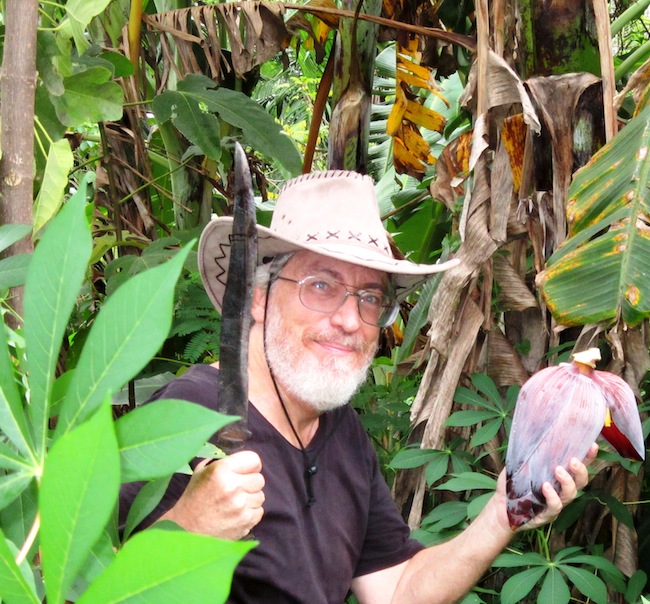
Bananas, in the wild, come in many varieties, shapes, sizes, and colors. The Saba is a thick banana. It is much like the plantain in the supermarket that everyone looks at but no one seems to know what to do with. The Saba is used for boiling into soups and stews, or just boiled, peeled, and eaten cold much like a potato. It is also boiled in sugar water to make a delicious dessert called banana glaze. It can also be deep-fried and rolled in sugar to make banana-que. Lakatan and Latundans are both sweet, eating banana, with the Lakatan being the sweetest-tasting banana I have ever eaten, especially when it is freshly picked. Empress bananas are the tiniest bananas, about the size of the palm of your hand and can be eaten in about two or three tasty bites. The long, yellow, perfect banana that you see in the supermarket is called a Cavendish. It is probably originally from near here. But your perfect banana, domesticated and grown on enormous plantations throughout the tropics, is no longer a wild banana.
by B.J. Stolbov
When I was in the United States, commuting every day by bus to work in the Financial District of San Francisco, I took the #2 Clement Street bus. Since I lived near the beginning of the line, there were always plenty of empty seats to choose from, if I got to the bus stop at 7:38 a.m. If I got there at 7:39, the bus was gone, and I would be late for work. If I got there at 7:38:01, the bus would be pulling out, its engine revving, exhaust fumes spewing, as I ran as fast as I could, and shouted as loudly as I could, and pounded as hard as I could on the side of the bus. Sometimes, the bus would stop; most of time, it wouldn’t.
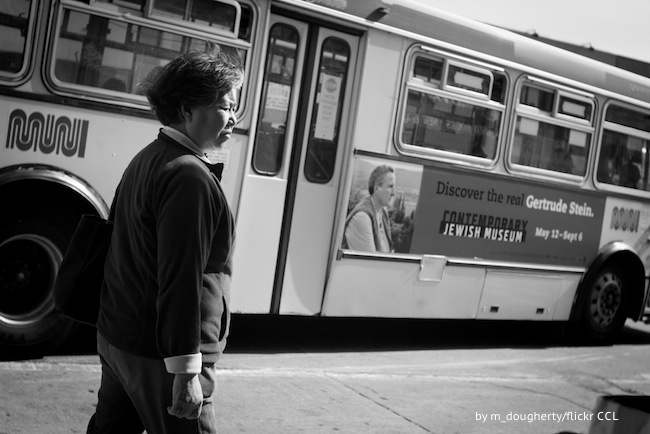
When I first got on a bus, actually a small van, in my province in the Philippines, I was on time; in fact, I was early. I had the whole van to myself and I had my choice of seats. I was so excited! This was great! And then, we waited and waited. We did not go anywhere, as passengers, one by one, or two or three, climbed into the van, and we waited until the 12 seats were filled, and, if the driver wanted, we waited until 13 or 14 passengers were crammed into the van, and, maybe one or two old people sat on the front seat beside the driver, and perhaps one or two young men climbed up onto the roof, and we waited, maybe 45 minutes to an hour, until the driver decided that the van was full.
Typhoon Yolanda: “The Storm of the Century” and more to come
by B.J. Stolbov
[Author's Note: Typhoon Yolanda, also known by its international name of Typhoon Haiyan, hit the Philippines on November 7, 2013. In honor of the dead and missing, I will use its Filipino name, Yolanda.]
The Philippines are surprisingly long. They may look like just a bunch of specks (7107 islands) at the end of the Pacific Ocean, but from the Batanes Islands beyond the end of Luzon Island in the north to the Tawi-Tawi Islands at the end of Mindanao Island in the south, the Philippines are long (1,150 mi.). They are almost as long as west coast of the U.S. from Seattle to San Diego (1,293 mi.). Because of its length, its many islands, and its moving ocean currents, the weather can change considerably from island to island, even from the exposed windward side to the more protected leeward side of any island.
Here, in Northern Luzon, we are protected from typhoons by the mountains. For a typhoon to hit us directly, it has to come in from the southeast, low off the water, through the beaches and lowlands of Aurora, then up the Cagayan Valley, and then into the hills and mountains. This is what we call a "low" typhoon.
Typhoon Labuyo, “the storm of the year” at that time, hit us on August 12 in Quirino. It came in “low,” knocked down all the corn, just before harvest; and all the bananas, which will grow back on their own in nine months. It flooded all the rice paddies, but rice is used to water. Lots of crops and houses were destroyed, but, thankfully, no deaths.
Debt of Gratitude
by B.J. Stolbov
The family, after doing without and saving for years and years, had finally bought a small farm of less than a hectare for 900,000 pesos. They had negotiated the price with the owner, an absentee landlord. He had wanted 1,000,000 pesos; the family had only 800,000 pesos. After long and difficult discussions, they agreed to a price of 900,000 pesos, not in installments, but paid as one sum. A retired judge officially wrote up the paperwork. Both parties signed the bill of sale. 900,000 pesos were paid in full.

[Note: the currency exchange rate is 1 US $ = 43 Philippine pesos. So, for a house and a hectare, less than 2.5 acres, the price is almost $21,000.]
As is necessary in such transactions, there are additional local fees: a Documentary Stamp, a Certification for the Bureau of Internal Revenue, and, finally, the largest, a Sales Tax.
In charge of the family finances is Maria, a pharmacist, who is good with numbers and knows how to run a business. With Jerold, her brother-in-law, a large, friendly man, a mechanic and driver, who works for the local government and knows how it works, Maria goes to the Municipal Office to register the land. At the Assessor’s, the land is again assessed. It is from this assessed value that the sales tax to pay to the government is determined.
I Bought Myself a Wedding Ring in Siem Reap
by B.J. Stolbov
Today, in a shop in the public market of Siem Reap, Cambodia, I bought myself a wedding ring.
I had a wedding ring already, which I had bought last August in a jewelry shop in the Philippines on one of the hottest days of the year. My hands had been sweaty and swollen when I made the purchase. But as the days cooled, and my hands dried and shrank, it became obvious that the ring was too big. I would often find it dangling at the end of my finger, barely hanging on by a nail, only one intense instant away from eternal loss. I'd catch it and push it back on again.
I didn’t bring the ring to Siem Reap. It just didn’t fit.
It also didn’t fit because I wasn’t sure that I wanted it to fit. I had been married for 20 years and single for more than 10 years. I had slid easily into relationships and had slid easily out of relationships. Until Grace.
by B.J. Stolbov
As the only (old) white man with a (long) white beard in my rural Filipino community of Northern Luzon, I get the exceedingly great pleasure every December of being Santa Claus.
I am a volunteer high school teacher. My first year here, I was asked to play Santa Claus at my high school’s Christmas assembly. I excitedly volunteered. Dressed in a red t-shirt and red jogging pants (the colors of our school), my black rubber swamp tromping boots (cleaned), a red cap with battery operated white blinking stars, my wire-rimmed glasses, and my long white beard, I, Santa Claus, appeared from the back of the stage of the school gymnasium to loud amplified blaring Christmas music.
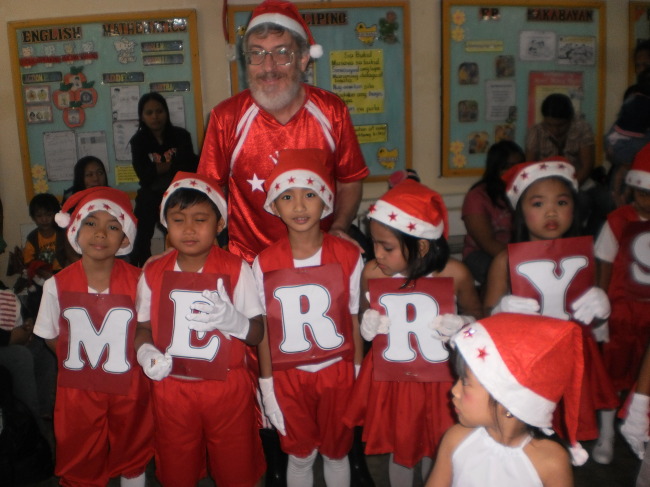
One thousand students went wild. This was my ultimate rock star Santa Claus moment. I strode across the stage waving, and then waded down into the roaring crowd. Carrying a red bag filled with candy, I threw handfuls of candy everywhere. It was almost a sugar frenzy riot. Everyone loves Santa Claus. No wonder he does this! What a rush! I felt like Santa Claus.
Next year, I was again invited to play Santa Claus. But not only at my high school, where now, of course, everyone knew me; but also at an elementary school, where few, if any, of the kids knew me. I cheerfully accepted.
I arrived at the elementary school dressed in regular clothes, with my Santa outfit hidden in my tightly folded red bag. The principal of the school had made all the arrangements, agreeing with me that no one, except for a few teachers, would know that Santa Claus was coming to their school. In the principal’s office, I changed into my Santa outfit.



